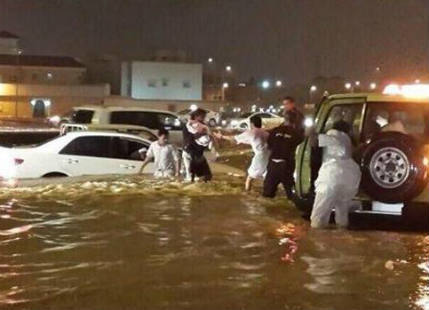Saudi Arabia: Adverse weather forecast across western regions through at least Aug. 29
Adverse weather conditions, including heavy rainfall, thunderstorms, and strong winds, are forecast across western Saudi Arabia through at least Aug. 29. Heavy downpours could result in flooding in parts of the affected region. Strong winds could generate dust storms, and transport disruptions are possible due to the reduced visibility caused by the rising dust.
As of early Aug. 23, the National Center for Meteorology has issued the following weather warnings across the affected area:
Red heavy rain and thunderstorm warnings (the highest level on a three-tier scale): eastern and central Al Bahah, western and central Aseer, most of Jazan, and central Mecca provinces
Orange heavy rain and thunderstorm warnings: the rest of Al Bahah, the rest of Aseer, far northwestern Jazan, the rest of Mecca, and most of Medina provinces
Yellow heavy rain and thunderstorm warnings: the rest of the affected area
Authorities will likely issue new alerts or update/rescind existing advisories as weather conditions change over the coming days.
#VIDEO: Heavy rain and strong winds around the vicinity of the Grand Mosque in Makkah.
pic.twitter.com/nMh5haq1HO— Saudi Gazette (@Saudi_Gazette) August 22, 2023
Hazardous Conditions
Sustained heavy rainfall could trigger flooding in low-lying communities near rivers, streams, and creeks. Urban flooding is also possible in developed areas with easily overwhelmed or lack stormwater drainage systems. Sites located downstream from large reservoirs or rivers may be subject to flash flooding after relatively short periods of intense rainfall. Landslides are possible in hilly or mountainous areas, especially where the soil has become saturated by heavy rainfall.
Authorities may issue mandatory evacuation orders for flood-prone communities over the coming days. Disruptions to electricity and telecommunications services are possible where significant winds, flooding, and/or landslides impact utility networks. Due to the arid nature of the region and poor stormwater management in some urban areas, even minor rainfall accumulations could quickly result in episodes of flash flooding. Flooding is possible in streams and wadis (dry riverbeds). Moderate winds and dust storms may precede significant rainfall, though some areas – particularly desert areas – may experience high levels of dust without rain.
Transport
The severe weather could contribute to transport disruptions throughout the affected area. Floodwaters and debris flows could render some bridges, rail networks, or roadways impassable, impacting overland travel in and around affected areas. Traffic and commercial trucking delays might occur along regional highways. Authorities could temporarily close some low-lying routes that become inundated by floodwaters. Strong winds might also pose a hazard to high-profile vehicles. Hazardous weather conditions might cause flight delays and cancellations at airports in the region.
Localized business disruptions may occur in low-lying areas; some businesses might not operate at full capacity because of flood damage to facilities, possible evacuations, and some employees’ inability to reach work sites.
Advice
Seek updated information on weather and road conditions before driving through areas where severe weather is forecast. Plan accordingly for potential freight delivery delays if routing shipments by truck through the affected area. Do not attempt to drive through flooded areas. Review contingency plans. Charge battery-powered devices in the case of prolonged electricity outages.
Resources
National Center for Meteorology – Kingdom of Saudi Arabia
